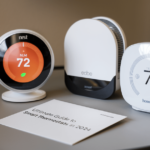Smart thermostats have revolutionized home climate control, combining energy efficiency, advanced technology, and convenience into a single device. As we step into 2024, smart thermostats are becoming more sophisticated, offering AI-driven insights, integration with smart home ecosystems, and features that cater to sustainability-conscious users. In this comprehensive guide, we will explore the latest advancements, top brands like Nest and Ecobee, and how to choose the perfect smart thermostat for your needs.

Smart Thermostats in 2024
The smart thermostat market in 2024 is dominated by devices that prioritize energy efficiency and seamless integration with smart home ecosystems. These devices not only regulate temperature but also provide insights into energy usage, helping homeowners make informed decisions. With manufacturers like Nest, Ecobee, and Honeywell leading the way, smart thermostats are now a must-have for tech-savvy and eco-conscious consumers.
What Are Smart Thermostats?
A smart thermostat is a device that allows homeowners to control their HVAC (heating, ventilation, and air conditioning) system remotely using a smartphone, tablet, or voice commands. Unlike traditional thermostats, these devices use sensors, algorithms, and connectivity to automate and optimize temperature settings.
Key Features of Modern Smart Thermostats
AI-Powered Learning
Smart thermostats like Nest and Ecobee use AI to learn your schedule and preferences, automatically adjusting the temperature to optimize comfort and energy savings.
Voice Control and Integration
Modern devices integrate with voice assistants like Alexa, Google Assistant, and Siri, allowing users to control their thermostat hands-free.
Geofencing Capabilities
Geofencing uses your smartphone’s location to determine whether you’re home or away, adjusting the temperature accordingly to save energy.
Top Smart Thermostats in 2024
Nest Thermostats
Nest, a Google-owned brand, continues to lead the market with intuitive designs and robust features. The Nest Learning Thermostat (4th Gen) offers advanced AI capabilities, while the Nest Thermostat E is a budget-friendly alternative.
Ecobee SmartThermostats
Ecobee stands out with its room sensors that ensure every part of your home stays comfortable. The Ecobee SmartThermostat Premium integrates seamlessly with Alexa and offers built-in air quality monitoring.
Honeywell Home
Honeywell’s T10 Pro Smart Thermostat provides room-specific temperature control and excellent smart home integration.
Energy Efficiency and Savings
Smart thermostats can reduce energy bills by learning your habits and avoiding unnecessary heating or cooling when you’re away. Reports suggest that users can save up to 20% on energy costs annually by switching to a smart thermostat.
Smart Home Integration
The ability to connect with a broader smart home ecosystem is a crucial feature. Nest and Ecobee thermostats work well with popular platforms like Google Home, Amazon Alexa, and Apple HomeKit. Integration with other smart appliances, such as blinds and fans, further enhances convenience and energy savings.

Smart Thermostat Technologies
Sensors and Room-Level Control
Advanced thermostats include motion and temperature sensors to provide room-level control, ensuring that your home remains comfortable in every area.
Advanced Scheduling Options
Customizable schedules let you pre-set temperatures for different times of the day.
Machine Learning Algorithms
Thermostats like the Nest Learning Thermostat adapt to your habits over time, automating temperature adjustments to suit your lifestyle.
Smart Thermostats for Different Needs
Best for Apartments
- Nest Thermostat E: Compact and budget-friendly.
Best for Large Homes
- Ecobee SmartThermostat Premium: Room sensors ensure comprehensive coverage.
Best for Smart Home Enthusiasts
- Honeywell T10 Pro: Fully integrates with advanced smart home systems.
Installation and Setup
DIY Installation Guide
Many smart thermostats are designed for DIY installation and come with step-by-step instructions.
Professional Installation
Professional installation is recommended for older HVAC systems or for those who prefer a hassle-free setup.
Comparing Nest vs. Ecobee
Feature Comparison
- Nest: AI-driven learning, minimalist design.
- Ecobee: Superior room sensors, built-in air quality monitoring.
Cost Analysis
- Nest Thermostat E: Affordable and feature-rich.
- Ecobee SmartThermostat Premium: Slightly pricier but packed with extras.
Customer Reviews
Both brands have high customer satisfaction rates, with Nest praised for its ease of use and Ecobee for its advanced features.
Best Budget-Friendly Smart Thermostats
For those on a budget, the Amazon Smart Thermostat and the Wyze Thermostat offer excellent value with basic smart features.
Thermostats with Sustainability Features
In 2024, manufacturers are focusing on eco-friendly options:
- Solar Integration: Some models connect directly to solar panels.
- Recyclable Materials: Brands like Ecobee are using sustainable packaging and components.
Troubleshooting Common Issues
Connectivity Problems
Ensure your thermostat is within range of your Wi-Fi router and restart the device if necessary.
Calibration Errors
Check the placement of your thermostat and recalibrate it using the app or manual.
Future Trends in Smart Thermostats
Predictive Maintenance
Future thermostats will predict when your HVAC system needs maintenance, preventing costly repairs.
Enhanced Security Features
Encryption and two-factor authentication are becoming standard to protect user data.
Integration with Renewable Energy Sources
Expect smarter systems that optimize energy usage based on renewable energy availability.
Frequently Asked Questions (FAQs)
1. Which is better: Nest or Ecobee?
Both are excellent. Nest excels in AI-driven simplicity, while Ecobee offers more advanced features like room sensors.
2. Do smart thermostats save money?
Yes, they can reduce energy bills by up to 20% through efficient temperature management.
3. Can I install a smart thermostat myself?
Most smart thermostats offer DIY installation, but professional help may be needed for older systems.
4. Are smart thermostats compatible with all HVAC systems?
Many are compatible with most systems, but it’s essential to check the manufacturer’s specifications.
5. What is geofencing in smart thermostats?
Geofencing adjusts the temperature based on your location, automatically switching to energy-saving modes when you’re away.
6. What happens during a power outage?
Most smart thermostats retain their settings and reconnect to Wi-Fi automatically when power is restored.
Conclusion
Smart thermostats in 2024 offer a blend of convenience, energy efficiency, and advanced technology. Whether you choose a Nest, Ecobee, or another brand, these devices can transform your home into a smart, comfortable, and sustainable space. With options for every budget and lifestyle, now is the perfect time to upgrade to a smarter way of managing your home’s climate.






